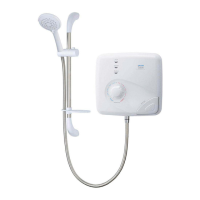SITING OF THE SHOWER
For ease of servicing, the unit must always be
mounted on the surface of tiled walls. Never
tile up to the unit.
Refer to (Fig.6) for correct siting of shower.
Position the unit where it will not be in direct
contact with water from the showerhead.
Position the shower unit vertically.
Allow enough room between the ceiling and the
shower to access the cover top screws.
Note: Water Regulations (shower hose
connections) requires the showerhead be
‘constrained by a fixed or sliding attachment
so that it can only discharge water at a point
not less than 25mm above the spill-over level
of the relevant bath, shower tray or other fixed
appliance’. The use of the supplied soap dish will
in most cases meet this requirement, but if the
showerhead can be placed within a bath, basin
or shower tray, then a double check valve, or
similar, must be fitted in the supply pipework to
prevent back-flow.
Pressure relief safety device
A pressure relief device (PRD) is designed into
the shower unit which complies with European
standards. The PRD provides a level of appliance
protection should an excessive build up of
pressure occur within the shower.
Do not operate the shower with a damaged or
kinked shower hose, or a blocked showerhead
which can cause the PRD to operate.
When commissioning, the showerhead must
be removed from the flexible hose. Failure to
follow this procedure may also cause the PRD to
operate.
Make sure the shower is positioned over a bath
or shower tray because if the PRD operates, then
water will eject from the bottom of the unit.
Should this happen, turn off the electricity and
water supplies to the shower at the isolating
switch and stopvalve. Contact Customer Service
for advice on replacing the PRD.
WARNING!
The shower must not be
positioned where it will be subjected
to freezing conditions.
Fig.6
Diagrammatic view (not to scale)

